Bosch DDS182-02L 1/2″ Compact Drill/Driver with 18-volt Brushless Motor
The Bosch DDS182 drill/driver can deliver arm-wrenching torque for drilling or it can drive machine screws to just a little more than finger tight. One battery lasts through several high-torque, long-duration operations followed by dozens of less intensive operations. If a recharge is necessary, the included charger can take a battery from flat to full in a little under two hours. It might be time for this reviewer to cut the cord and move from the trusted reliability of an electric drill to this 18-volt drill/driver.
Model Numbers Explained: The Drill/Driver itself (model DDS182, $199 tool/battery only at Home Depot) was reviewed as part of a set (model number DDS182-02L, $219 at Home Depot.) The major components of the set included a charger (model number BC660), two 18V, 2.0 Ah lithium ion batteries, and a carrying case (model L-BOXX-2) with molded inserts.
Diving Deeper
Drill/drivers are popular tools among professionals and consumers alike, but historically they have not been without their shortcomings. As an Audio/Video installer, I have on several occasions lent my electric drill to other trades when their batteries ran out of juice or their tool lacked the torque to get the job done. As a result, a battery-powered drill has never made its way into my toolkit, despite the allure of untethered use and the typical array of convenient features. By the way,
I usually fly to jobs, so tool selection is not as simple as throwing another box in the truck.
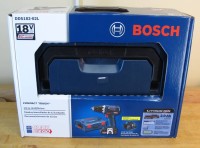
When the Bosch DDS182 drill/driver kit arrived, excitement was balanced with skepticism. Not only would the torque and longevity of the tool’s drilling operations be tested, but the sensitivity of the clutch for driving operations would also be challenged. To that end, a series of operations was devised that would simulate the variety of tasks encountered during a typical A/V install:
- Drilling 2” diameter holes in 3/4″ plywood with a hole saw,
- Drilling 1/2″ diameter holes through studs,
- Driving machine screws finger tight, and
- Driving drywall screws flush in wood.
It is hoped that the variety of torques, drilling durations, and clutch sensitivities used in this test is broad enough to give all readers a sense of this tool’s capabilities, regardless of their application.
Test Results
In a word, impressive. All of the operations described in the following paragraphs were completed using a single battery that had been fully charged two weeks prior to conducting the test.
2” Hole Saw, 3/4″ Plywood: The review began with cutting 2” diameter holes through 3/4″ plywood. The hole saw that was used had knocked around in a tool kit for several years, so it was not new and sharp. The plan was to cut holes until the Bosch gave out, bogged down, or the battery ran out of juice. After the tenth hole was cut and the reviewer’s arm was a little looser in its socket due to a grabby hole saw and the resulting kick of the Bosch, it was determined that the Bosch was quite capable when it came to cutting 2” holes. Low gear was used during this operation with clutch set to drill mode. The only indication that the Bosch might have been breathing a little heavily was that the battery level indicator dropped from a full charge of three LEDs to two LEDs during this operation.
1/2″ Spade Blade Drilling, 4” deep hole: Ten 1/2″ diameter holes were drilled through the 4″ dimension of a rough cut 2×4 using a new Irwin brand spade-blade drill bit. High gear was used with clutch set to drill mode and the Bosch DDS182 drilled the holes with no adverse events. This is to say that the Bosch simply drilled the holes exactly as one would hope a drill would.
1/2″ Twist Bit Drilling, 4” deep hole: Ten 1/2″ diameter holes were drilled with an almost-new twist bit through the same 4″ dimension of the rough-cut 2×4. High gear was used with clutch set to drill mode and again, the Bosch DDS182 drilled the holes with no adverse events.
Driving Machine Screws: Fifty 3/4″ machine screws were inserted to finger tight and then removed in the rails of an A/V rack. This was a very repetitive, forward and reverse operation that exercised operator controls and the clutch. High gear was used with clutch set to the minimum setting of 1 during driving. Sometimes the clutch needed to be set higher to remove a screw. This only happened when screws were inserted with high RPM and inertia seemed to tighten the screw a little more than when lower, controlled RPMs were used. At the end of this operation, the battery LED indicator had dropped to one indicator being lit.
Driving 2-1/2″ Gold Drywall Screws: At this point in the review, drywall screws were going to be sunk and removed until the battery went flat. Eleven 2-1/2″ gold drywall screws were sunk into the 2×4 and removed before the battery went flat when driving the twelfth screw. Low gear was used with clutch set to drill mode. No loss of performance was observed during end-of-charge operations until function abruptly ceased during the twelfth screw.
Overall, the Bosch exceeded expectations for the drilling and driving tasks it completed. Performance when cutting the ten 2” holes was marked with continuous, raw drilling power. Equally impressive was the clutch sensitivity for driving machine screws. This yielded screws that were torqued to exactly the right amount, requiring only easy hand pressure to unscrew with the slightest “snap” being audible when screws broke loose.
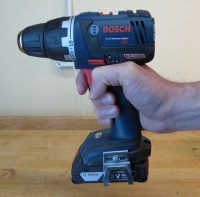
Using the Bosch was no more fatiguing than using a comparably sized electric drill. It might even be less fatiguing. It may be thought that the combined weight of the Bosch’s body + battery would exceed that of an drill, but measurements with a kitchen scale indicate that the Bosch is about an ounce less than the reviewer’s electric drill. If one considers the weight of the electric drill’s cord the difference is several ounces. The Bosch feels good in the hand because the weight of the battery hangs below the hand, offsetting the weight of the body of the drill which is above the hand. By comparison, all the weight of an electric drill is above the hand and ones wrist must work to counteract that top-heaviness. The accuracy that the Bosch’s balance affords was obvious when driving multiple screws; it was easy to position the bit on a fastener.
Features and Functions of the Drill/Driver and Accessories
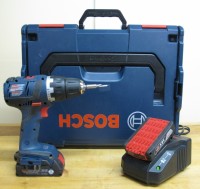
The Bosch DDS182 drill/driver itself was reviewed as part of a set (model number DDS182-02L) whose main components included two batteries, a charger (model number BC660), and a hard plastic storage/carrying case with inserts that are molded to hold everything in the set.
The drill/driver itself had several settings and features that makes it a very versatile tool. These settings include:
Forward and reverse lever with trigger lock. For a right-hander, this lever works as expected with an index finger push resulting in forward and a thumb push resulting in reverse. The lever has a middle “trigger lock” position between forward and reverse which seemed like an unnecessary feature, until this reviewer accidentally triggered the drill while tightening the keyless chuck. It is now obvious that this lock position is a smart safety feature that can help prevent inadvertent operation of the drill/driver.
Gear shifter. There is a switch on top of the drill/driver that can be slid from mode “1” to mode “2.” Mode 1 is low gear which results in lower RPM with more torque. Mode 2 is high gear with higher RPM. These modes were utilized during the review and the tool performed admirably during operations that needed more torque (e.g., hole saw drilling and driving drywall screws) and operations that lent themselves to higher RPM (e.g., drilling with twist and spade bits.)
Adjustable Clutch. The clutch can be engaged using incremental settings that range from 1 to 18 or it can be disengaged by selecting the drill setting. During testing, the clutch was set to either a very low setting (i.e., 1 – 3 for driving and removing machine screws) or the drill setting (i.e., for drilling and driving screws into wood.) The clutch was a useful feature that enabled the tester to set machine screws with as little torque as desired. Intermediate settings were explored and as expected they added more or less torque before the clutch slipped.
Keyless Chuck. The keyless chuck on this tool is very easy to use. To loosen or tighten, twist the chuck collar with one hand and hold the body of the tool with the other. There is no “secondary” chuck collar to manipulate as can be found in other, perhaps older, drill designs. During testing, the chuck held the smooth, HSS shaft of the ½” twist bit without slipping. All other bits used during testing had hex shafts, which were also held securely.
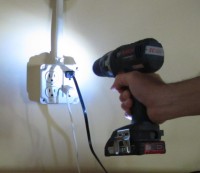
Brake. This drill/driver includes a brake that engages when the trigger is released. This stops the rotation of the drill quickly when the trigger is released which is greatly appreciated during repetitive driving operations.
Belt Clip. Chief among the convenience accessories of this drill/driver is a belt clip. The Bosch’s clip worked well with a 1-1/2″ heavy leather belt and the drill/driver hung securely with a variety of drill bits. This is much better than balancing a drill on the top step of a ladder.
Built in Work Light. The built in work light is a small light in the base of the tool, below where the operator’s little finger grips the handle. This light clearly illuminated the A/V rack when 50 machine screws were inserted and removed. Perhaps it is a trivial thing to mention, but the built in work light worked much better than the reviewer expected. Gone are the days of standing on top of a 6-foot ladder with your head in a plenum and a flashlight clenched in your teeth.
Two SlimPack batteries were included with the set and are rated as 18 V, 2.0 Ah Lithium-Ion. Each battery has a test button labeled “On” that activates a battery level indicator consisting of three LEDs. There is also an easy-to-push button on the front of the battery that allows removal of the battery from the tool, even when wearing gloves. The bottom of the battery is large and flat and provides study footing for standing the drill/driver upright, even when a heavy bit like a 2″ hole saw is chucked. Batteries are easy to insert and remove from both the tool itself and the charging station.
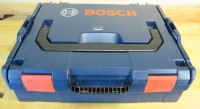
The reviewer suspects that the energy management of the Bosch DDS182 is especially shrewd. After periods of non-use, the first trigger squeeze results in a momentary lag before the motor starts. Subsequent trigger pulls result in instantaneous reactions. It is suspected that this lag after non-use is evidence of some sort of “hibernation” mode that the tool reverts to during periods of inactivity. If so, this effort to conserve every shred of battery life is greatly appreciated.
The battery charger is easy to use with a single attention-getting LED that blinks when charging and goes steady on when charging is complete. Charging a battery from flat takes about 1 hour and 50 minutes.
The hard plastic storage/carrying case (Model L-BOXX-2) has plastic inserts that are customized to the components included in this kit. The inserts hold everything securely in place, even through the rigors of shipping. The case itself has notches and latches that will mate with and secure multiple boxes together. Bosch refers to this system as Click & Go. Click & Go operation was not tested in this review because the reviewer only had one Click & Go box.
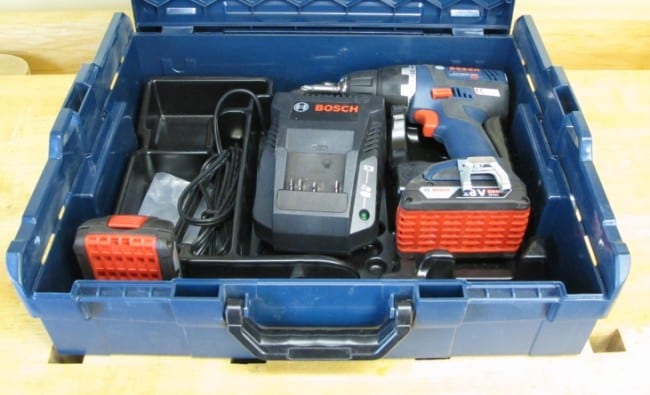
Also included in this kit are four screwdriver bits, a magnetic hex shaft bit holder, a manual with miscellaneous other informative inserts, and two accessories that can be screwed to the base of the tool: a plastic “bit holder” and a belt hook. Both the belt hook and the bit holder were fastened to the drill/driver and proved useful. It was easy to imagine utilizing the belt hook while standing on a ladder and working in a drop ceiling.
Conclusion
Overall, the Bosch DDS182 delivers everything this reviewer wanted in an easy-to-operate form factor and with a kit of useful accessories. It is a great tool and during the short time it spent in shop it supplanted the electric drill as the preferred tool for drilling. There may be times when an electric drill is needed, perhaps the next time a deck is built and many holes for carriage bolts are drilled, but the Bosch DDS182 would still be used first. And as difficult as it is to change old habits, the Bosch has replaced the electric drill in my A/V installer toolkit.
Manufacturer Specifications: Bosch DDS182-02L 18V EC Brushless Compact Tough 1/2″ Drill/Driver
- Battery Chemistry: Lithium Ion
- Battery Voltage: 18V
- Chuck Size: 1/2″
- Clutch Settings: 18+1
- Height: 7.75″
- Length: 7″
- No Load RPM: 0-500 / 0-1,700
- Torque (in. lbs.): 442
- Warranty: Limited 1 Year, 3 Year with ProVantage
- Weight3.5 lb
Included as part of the set:
- (2) – Lithium Ion Slimpack Batteries
- (1) – Charger
- (1) – LBoxx 2
- (2) – Exact Fit Insert Trays
- (1) – 4X Bit Tip Holder
- (1) – 4 Piece Bit Tip Set
- (1) – Magnetic Bit Tip Holder
- (1) – Belt Clip


